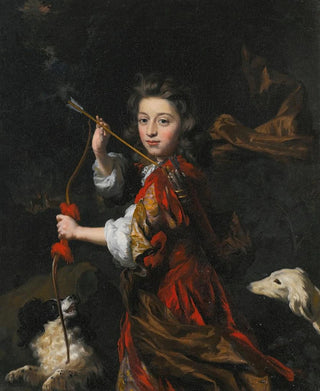Art print | Portrait of a young noble - Nicolaes Maes


View from behind

Frame (optional)
Portrait of a Young Noble - Nicolaes Maes – Engaging Introduction
In the captivating world of 17th-century painting, the "Portrait of a Young Noble" by Nicolaes Maes stands out for its elegance and refinement. This artwork, both intimate and majestic, offers a poignant glimpse into Dutch nobility of the era, capturing not only the physical appearance of the subject but also his essence and social status. Through this portrait, Maes manages to establish an emotional connection with the viewer, inviting each to contemplate the personality of this young noble. Every detail, every shade of color, seems imbued with meaning, revealing the subtleties of aristocratic life in the 17th century. Immersing oneself in this work, one feels the richness of a time when art and society were deeply intertwined.
Style and uniqueness of the work
Nicolaes Maes's style is characterized by an exceptional mastery of light and shadow, a technique that allows him to bring his subjects to life. In the "Portrait of a Young Noble," the soft light illuminating the young man's face creates an atmosphere that is both serene and emotionally charged. The sumptuous clothing, depicted with remarkable attention to detail, testifies to the wealth of the model, while being treated with a delicacy that highlights the artist's virtuosity. The pose of the young noble, both relaxed and confident, evokes a quiet self-assurance, while his gaze, both thoughtful and engaging, seems to invite the viewer to share a moment of reflection. This portrait stands out for its ability to transcend mere physical rendering, becoming a true psychological exploration of the character.
The artist and his influence
Nicolaes Maes, a pupil of Rembrandt, mastered his master's techniques while developing a personal style that is uniquely his own. Active in Delft, he captured the spirit of his time, blending realism and idealization in his portraits. His career, marked by stylistic evolution, reflects the influence of the great masters of Dutch painting, but also a unique capacity for innovation. Maes established himself in the artistic landscape of his era, influencing many contemporaries and successors through

Matte finish

View from behind

Frame (optional)
Portrait of a Young Noble - Nicolaes Maes – Engaging Introduction
In the captivating world of 17th-century painting, the "Portrait of a Young Noble" by Nicolaes Maes stands out for its elegance and refinement. This artwork, both intimate and majestic, offers a poignant glimpse into Dutch nobility of the era, capturing not only the physical appearance of the subject but also his essence and social status. Through this portrait, Maes manages to establish an emotional connection with the viewer, inviting each to contemplate the personality of this young noble. Every detail, every shade of color, seems imbued with meaning, revealing the subtleties of aristocratic life in the 17th century. Immersing oneself in this work, one feels the richness of a time when art and society were deeply intertwined.
Style and uniqueness of the work
Nicolaes Maes's style is characterized by an exceptional mastery of light and shadow, a technique that allows him to bring his subjects to life. In the "Portrait of a Young Noble," the soft light illuminating the young man's face creates an atmosphere that is both serene and emotionally charged. The sumptuous clothing, depicted with remarkable attention to detail, testifies to the wealth of the model, while being treated with a delicacy that highlights the artist's virtuosity. The pose of the young noble, both relaxed and confident, evokes a quiet self-assurance, while his gaze, both thoughtful and engaging, seems to invite the viewer to share a moment of reflection. This portrait stands out for its ability to transcend mere physical rendering, becoming a true psychological exploration of the character.
The artist and his influence
Nicolaes Maes, a pupil of Rembrandt, mastered his master's techniques while developing a personal style that is uniquely his own. Active in Delft, he captured the spirit of his time, blending realism and idealization in his portraits. His career, marked by stylistic evolution, reflects the influence of the great masters of Dutch painting, but also a unique capacity for innovation. Maes established himself in the artistic landscape of his era, influencing many contemporaries and successors through






